More than meets the eye: how space telescopes see beyond the rainbow Understand article
How do astronomers investigate the life cycle of stars? At the European Space Agency, it’s done using space-based missions that observe the sky in ultraviolet, visible and infrared light – as this fourth article in a series about astronomy and the electromagnetic spectrum describes.
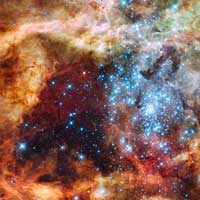
the Tarantula Nebula, in
ultraviolet, visible, and red
light
Image courtesy of ESA / Hubble
& NASA
When we look at the night sky, the cosmic landscape that we see is shaped by stars. Although most appear as points of white light, some – even to the naked eye – appear coloured. A striking example can be seen in the constellation Orion, the hunter: his right shoulder is the red supergiant star Betelgeuse and his left knee, the blue supergiant Rigel.
The ‘colours’ are due to differences in the surface temperature of starsw1: hotter stars emit most of their light in the visible blue or ultraviolet regions of the electromagnetic spectrum, whereas cooler stars radiate at longer wavelengths, in the visible red or infrared regions (see Mignone & Barnes, 2011a).
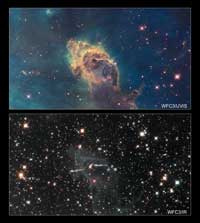
These two images
demonstrate how
observations taken in
visible and in infrared light
reveal dramatically
different views of an
object. In the bottom
image, taken in
near-infrared light, the
dense column and the
surrounding greenish-
colored gas all but
disappear. By penetrating
the gas and dust, the
infrared vision of WFC3
reveals the infant star that
is probably blasting the
jet.
Image courtesy of NASA, ESA,
and the Hubble SM4 ERO Team
But what makes a star hot or cool? There are two main factors: the stage of the star in the stellar life cycle, and its mass. Mass is important because it determines the rate at which a star burns its nuclear fuel: bigger stars burn up faster, producing much higher temperatures.
To probe how stars of all masses develop over their lifespan, their emissions in the range from ultraviolet (UV) to infrared (IR) are particularly important. Unfortunately, a large portion of these wavelengths are blocked by Earth’s atmosphere and the rest can be affected by atmospheric turbulence, so space-based telescopes have proved to be a crucial tool for investigating how stars form and evolve.
The European Space Agency (ESA)w3 has operated various space missions whose goal is to study this wavelength range – most notably the Infrared Space Observatory and the Herschel Space Observatory, both comprising large infrared telescopes – and participated in joint projects with other space agencies. Currently, ESA’s X-ray space observatory (XMM-Newton) is also equipped with a very sensitive UV and visible light telescope, the Optical Monitor (see Mignone & Barnes, 2011b). From these and many other observations, astronomers have built up a good picture of the stages in the lives of stars, with each stage in the pathway from birth to death depending on the mass of the star.
Massive stars
Although they are relatively rare, high-mass stars are the brightest and hottest of all, and are best observed at the shorter, higher-energy wave- lengths of UV to visible blue light. Such stars have masses of at least eight times that of the Sun and high surface temperatures of 10 000 K or more, but they exhaust their hydrogen supply more quickly than starts of lower mass: over some tens of mil- lions of years, compared to billions of years for stars like the Sun. During this time, high-mass stars produce powerful ‘winds’ (streams of energetic particles) that can trigger or halt star formation in their surroundings. Using data from the International Ultraviolet Explorer (IUE) satellite, astronomers have discovered how much of the star’s mass is carried away by these winds, which appears to increase as stars age.
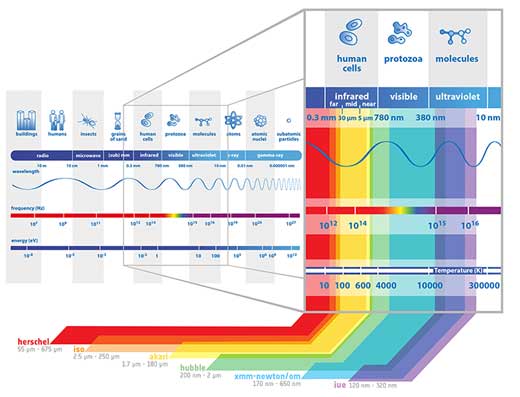
Image courtesy of ESA/ ATG Medialab

supernova SN 1987A in
visible and near-IR light
Image courtesy of ESA /
Hubble & NASA
Towards the end of their lives, massive stars expand rapidly and become red giants or supergiants, like Betelgeuse in the Orion constellation. With their very large radii and low surface temperatures, these radiate mostly in the longer wavelengths of visible (red) and IR light. Eventually, they explode as supernovae (see Székely & Benedekfi (2007) for more on the death of stars).
On 23 February 1987, light from a supernova explosion in the Large Magellanic Cloud first reached Earth. By comparing data from IUE before and after the explosion was observed, astronomers identified the progenitor star – and found that it was a blue, rather than a red, supergiant. Before 1987, astronomers believed that only red supergiants would explode as supernovae, but this observation proved that other types of evolved stars can produce these explosions too.
Blue supergiants are smaller and denser than their red counterparts; an example is Rigel in the Orion constellation. Since then, astronomers have been studying the aftermath of the explosion. Light from the supernova heats up the gas and dust in the surroundings, making it glow at visible wavelengths, while the cooler dust produced in the explosion shines at IR wavelengths (figure 1).
Low-mass stars
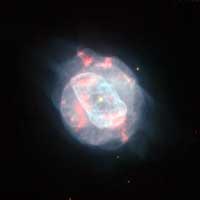
Telescope revealed that
planetary nebulae have a
huge variety of shapes.
Seen here in visible light is
a remarkably asymmetrical
planetary nebula (NGC
5882)
Image courtesy of ESA / Hubble
& NASA
The vast majority of stars have relatively low masses, similar to that of the Sun or even less. With surface temperatures ranging between 4000 and 10 000 K, these stars dominate the visible wavelengths, shining brightly in yellow, orange and red light. They burn hydrogen more slowly than massive stars, with lifetimes stretching to tens of billions of years. Low-mass stars also become red giants towards the end of their lives, expanding and cooling at the surface. Finally, they expel their outer layers, producing expanding shells of gas called planetary nebulae (figure 2). These eventually disperse and leave behind hot, compact objects known as white dwarfs.
In our own galaxy, the Milky Way, most stars have even lower masses – around half that of the Sun or less – with cooler surfaces that radiate mainly at the shortest IR wavelengths, called near-IR.
The death of such a very low mass star has never been observed, because the age of the Universe itself is less than their lifespan: thousands of billions of years, or even more.
The coolest material in the Universe shines in the far-IR wavelengths targeted by Herschel, and in longer microwave wavelengths as probed by Planck, a satellite that was launched together with Herschel in 2009. In our next article, we will describe how these two missions are further advancing our understanding of star formation across the Universe.
Star formation and cosmic dust
Stars form from the interstellar medium – a diffuse mixture of gas and cosmic dust that is a galaxy’s reservoir for star formation. The dust absorbs visible light but is transparent to near-IR wavelengths, so astronomers use the near-IR range to peer through the dust and view complex processes in action, such as the formation of proto-planetary discs around newborn stars. These discs, first seen with Hubble, are seeds of future planetary systems like our own Solar System (figure 4). Protostars, which have not yet reached the temperature of fully fledged stars, also radiate strongly in IR wavelengths. The cosmic dust itself shines brightly at long wavelengths (the mid- and far-IR) due to its low temperature. Using these wavelengths, astronomers can see this dusty interstellar material in our own Galaxy and beyond, providing a preview of stars to come (figure 5). IR observations have also detected molecules that play a key role in the chemical reactions of star formation – such as interstellar water, which was first identified by the Infra- red Space Observatory in the late 1990s. Today, astronomers continue to unveil the complex chemical composition of star-forming regions by exploring the rich data set collected with the Herschel Space Observatory.
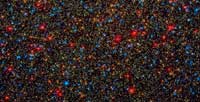
globular cluster Omega
Centauri. This image
combines data from UV
(shown in blue and green)
and near-IR wavelengths
(shown in red) to highlight
the different types of stars
in the cluster
Image courtesy of NASA / ESA
/ Hubble SM4 ERO Tea
Stellar clusters
As well as looking at single stars, astronomers study the evolution of stars of different sizes by looking at large groups of stars called stellar clustersw2. The Hubble Space Telescope, with its wide spectral coverage from UV to near-IR, provides amazing images of stellar clusters that portray the sheer variety of stars within them (figure 3). These images have led to some remarkable discoveries. For example, before Hubble, astronomers thought that stars in globular clusters (stellar clusters that formed when our Galaxy was still taking shape) were all born at the same time. The Hubble images showed that their stars formed during several distinct episodes, and that globular clusters are much more complex than previously thought. Other Hubble observations confirmed that bluer (hence more massive) stars tend to sink towards the centre of a globular cluster, while redder, smaller stars move to the periphery – an idea that had long been predicted from theory, but never seen.
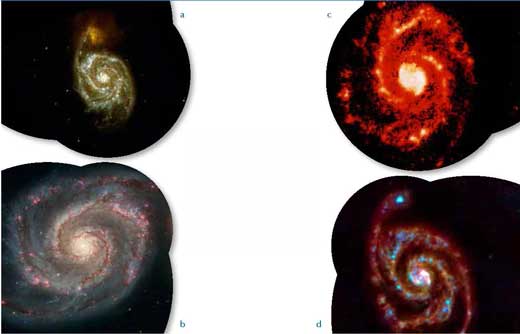
Image courtesy of: Marco Iacobelli (XMM-Newton SOC) and ESA [a]; NASA, ESA, S. Beckwith (STScI), and The Hubble Heritage Team (STScI/ AURA) [b]; ESA/ISO, CEA Saclay and ISOCAM Consortium [c]; ESA and the PACS Consortium [d]
More about ESA
The European Space Agency (ESA)w3 is Europe’s gateway to space, organising programmes to find out more about Earth, its immediate space environment, our Solar System and the Universe, as well as to co-operate in the human exploration of space, to develop satellite-based technologies and services, and to promote European industries. The Directorate of Science and Robotic Exploration is devoted to ESA’s space science programme and to the robotic exploration of the Solar System. In the quest to understand the Universe, the stars and planets and the origins of life itself, ESA space science satellites peer into the depths of the cosmos and look at the furthest galaxies, study the Sun in unprecedented detail, and explore our planetary neighbours.
ESA is a member of EIROforumw4, the publisher of Science in School.
References
- Mignone C., Barnes R. (2011a) More than meets the eye: the electromagnetic spectrum. Science in School 20: 51-59.
- Mignone C., Barnes R. (2011b) More than meets the eye: unravelling the cosmos at the highest energies. Science in School 21: 57-64.
- Székely P., Benedekfi Ö. (2007) Fusion in the Universe: when a giant star dies…. Science in School 6: 64-68.
Web References
- w1 – Find out how the wavelength at which a celestial object emits most of its light is related to the object’s temperature.
- w2 – Learn more about stellar clusters.
- w3 – For more information on the European Space Agency, visit the ESA website.
- w4 – Find out more about the EIROForum.
Resources
- To learn more about visible astronomy at ESA, watch Episode 4 of the Science@ESA vodcast from the ESA Science and Technology website.
- To learn more about IR astronomy at ESA, watch Episode 3 of the Science@ESA vodcast from the ESA Science and Technology website.
- Do some practical exercises about globular clusters.
- Check all the education materials produced by ESA.
- All education materials produced by ESA are freely available to teachers in the 18 ESA member states. Many are translated into several European languages.
- To learn more about the activities of the European Space Agency’s Directorate for Science and Robotic Exploration.
Institutions
Review
This article describes the life cycles of stars and how to investigate their behaviour. Research activities focus on ESA missions and their results.
The authors explain in a very interesting way how the mass of a star, its temperature and its wavelength are related to each other, and how this knowledge is applied in the very broad field of astrophysics research.
This article is useful mainly for physics lessons, particularly with its focus on astrophysics, but it also contains links to geography and even to languages.
The article would stimulate discussion around a broad range of questions, including:
- Describe the differences in the life cycle of massive stars and low-mass stars.
- Give an overview of the electromagnetic spectrum (e.g. visible, IR and UV light).
- Discuss the relationship between wavelength, energy and frequency
- Why do we use space observatories in addition to our ground-based observatories?
- What is the relationship between surface temperature and the colour (wavelength) of stars?
- How does the life cycle of a star depend on its mass?
- What are stellar clusters?
- What happens to massive stars at the end of their lives?
Gerd Vogt, Higher Secondary School for Environment and Economics, Yspertal, Austria






